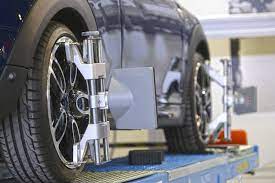Wheel alignment: Why is it important?
Your car is a complex system of inter-working elements. When one of these pieces is destroyed, it’s only a matter of time until the other related parts are harmed. One such issue that can get out of hand quite rapidly is poor wheel alignment in Batemans Bay. The alignment of your wheels influences your suspension and your tyre health.
What is wheel alignment?
Alignment is the process of adjusting the suspension, or "suspension system," of a vehicle such that the axel, or "nose," of the vehicle lines up with the centre of each wheel. It does not involve the wheels or tyres themselves. Adjusting the tyre's angular position is the primary means by which alignment is achieved, as this is what determines the tyre's grip on the road surface.
A mechanic's key concerns while assessing your vehicle's alignment are:
1. When viewed from the front, the camber describes how much the tyre leans inward or outward. An incorrect alignment is indicated by excessive inward or outward tilt, also known as negative or positive camber, respectively. Camber misalignment can also be caused by worn wheel suspension components such as bearings, ball joints, and others.
2. How much your tyres lean inward or outward when viewed from above is what's known as toe alignment. Consider the ground beneath your feet as an example. Toe-in alignment is when your toes point inside, and toe-out alignment is when they point outward.
3. Changing the caster angle can improve the vehicle's handling, traction, and cornering capabilities. When the caster is increased, the steering axis is shifted towards the driver. When the caster angle is negative, the steering axis is skewed in the direction of the front of the car.
Why do wheels go out of alignment?
A misaligned vehicle's wheels are often the result of a high-speed collision with an immovable object. Your vehicle's suspension, wheel alignment, and balancing can be severely compromised by contact with potholes and unprotected manholes, which can harm your fuel economy and, more critically, your safety. A car can also be knocked out of alignment by a minor collision or by scraping along the curb, but drivers often disregard these issues since they are not immediately apparent.
Symptoms of bad wheel alignment?
During driving, the vehicle pulls to one side
The necessity for a wheel alignment is the most common sign that your vehicle needs maintenance. If you are travelling in a straight line and let off of the steering wheel, the car should keep going in the same direction. This shouldn't constantly be tugging in the same direction, but depending on the state of the road, it might occasionally.
If you have to constantly hold the steering wheel in the same position, regardless of the road conditions, you may require a wheel alignment.
Your steering wheel is not aligned correctly
When your steering wheel is perfectly centred, so should your front wheels. If you centre the steering wheel while turning the vehicle, there is a problem with the vehicle's alignment. This exact issue could be related to the alignment of your wheels, steering wheel, or steering column. Regardless of the nature of the issue, alignment should resolve it.
Squealing noises while driving
An irritating screeching sound may be produced while driving if the misalignment is severe enough. The sound is caused by your tyres scraping the ground instead of rolling smoothly. These screeching noises will only occur if the alignment is extremely off, so if you hear them, don't hesitate to have them rectified.
Uneven tyre wear
If your vehicle's tyres aren't properly aligned, you'll have irregular and excessive tread wear. Even though regular tyre rotation can slow down the accelerated wear that results from this issue, it won't prevent it entirely.
Since you're not going in a straight line, one tyre is always bumping against the road. Due to the excessive wear caused by this, tyres must be replaced much earlier than usual. Steering and suspension parts at that wheel also experience increased tension and wear.
Vibrating steering wheel
Steering wheel vibrations are a common symptom of a severe need for wheel alignment. The tyre skipping across the pavement is what's causing the vibrations. The vibrations you feel are the consequence of stress placed on the steering components between the wheel and the tyres by the skipping.
It is important to never drive for an extended period with improper wheel alignment, as this will accelerate tyre wear. Always contact the experts for wheel alignment in Batemans Bay.
Disclaimer: This is a generic Information & post; content about the services can be changed from time to time as per your requirements and contract. To get the latest and updated information, contact us today or visit our website.



Comments
Post a Comment